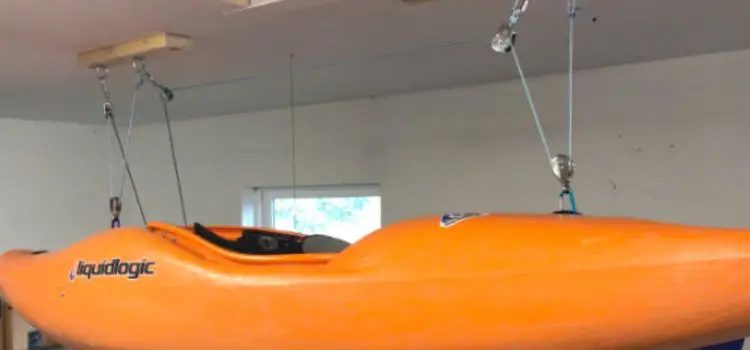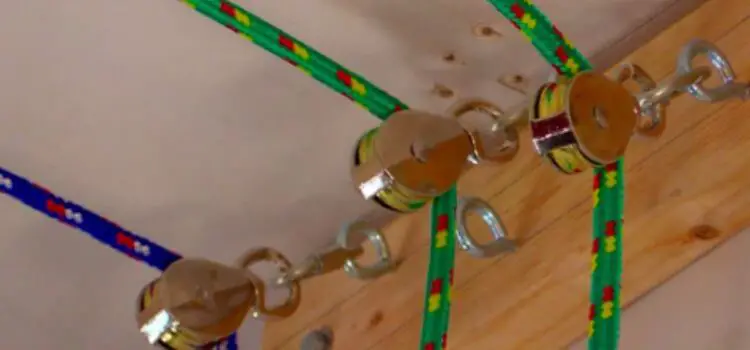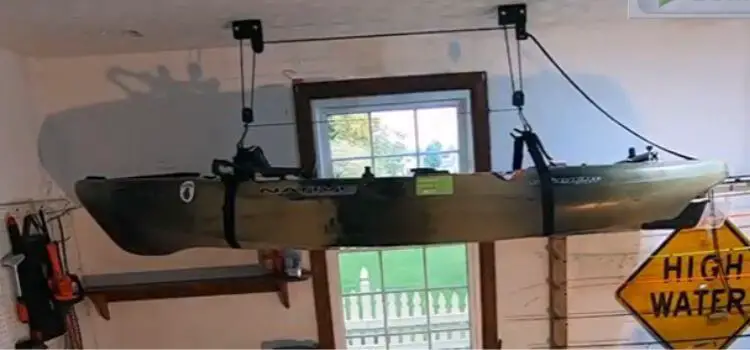As an Amazon Associates, I earn from quality purchases.
Are you searching for a practical solution to effortlessly lift your kayak? Look no further! In this article, we will explore the topic of “How to Set Up a Pulley System to Lift a Kayak?” If you know the answer, you can elevate your kayaking experience. You can hoist your kayak without straining your back.
Learn how to set up a pulley system to lift a kayak and enjoy the convenience and ease it offers. You might be a seasoned kayaker or a beginner. But this comprehensive guide will equip you with the necessary steps to make kayak lifting a breeze.
So, let’s dive in and discover how to set up a pulley system to lift a kayak with ease and efficiency.
Understanding Pulley Systems

Pulley systems are simple yet ingenious devices. They have been used for centuries to aid in lifting heavy loads.
The Basic Concept of Pulley System:
The basic concept of pulley systems revolves around the principle of mechanical advantage. By using multiple pulleys, the force required to lift a load is distributed and reduced. The more pulleys you incorporate into the system, the greater the mechanical advantage.
Advantages of Pulley System:
One of the key advantages of using a pulley system is the reduced physical strain on your body. By utilizing the mechanical advantage, you can apply less force to lift something. This is especially beneficial when dealing with bulky and cumbersome objects like kayaks.
The versatility of the Pulley System:
Pulley systems are also versatile and adaptable. They can be customized to suit different lifting needs and scenarios. You can lift your kayak from the ground to a roof rack. The pulley can suspend the kayak from a garage ceiling. You can transport it vertically in tight spaces by a pulley system.
The efficiency of the Pulley System:
Pulley systems are known for their efficiency. They provide a reliable and consistent method of lifting objects. The distribution of weight and the smooth operation of the pulleys ensure stability and control throughout the lifting process. This allows you to lift your kayak or any other heavy load with ease and confidence.
Using a Pulley System to Lift a Load
Pulley systems offer a practical and efficient solution for lifting kayaks and other heavy loads. Understanding their practical application, the mechanical advantage they provide, and employing effective techniques are key to utilizing a pulley system safely and efficiently. Let’s delve into these aspects:
Practical Application of Pulley Systems for Lifting Kayaks:
Pulley systems have found widespread use in the realm of kayak lifting due to their numerous advantages. Here are some practical applications of pulley systems for lifting kayaks:
Transportation and Storage:
A pulley system enables you to lift your kayak from the ground and transport it to a roof rack or storage area with ease. This is particularly beneficial when dealing with larger or heavier kayaks.
Garage or Workshop Setup:
Using a pulley system in your garage or workshop allows you to suspend your kayak from the ceiling. Thus, you can maximize storage space and keep it safe from potential damage.
Solo Lifting:
By utilizing a pulley system, you can lift a kayak on your own without requiring assistance. This is especially helpful when you don’t have someone available to help you with the lifting process.
Mechanical Advantage of a Pulley System for Lifting Heavy Loads:
The mechanical advantage of a pulley system works in the following way:
Force Distribution:
Pulleys distribute the weight of the load across the rope or cable into a lifting system. This distribution reduces the force required to lift the load and relieves your muscles.
Multiplication of Force:
Each additional pulley in the system increases the mechanical advantage. With multiple pulleys, the force needed to lift the load is reduced even further. This allows you to exert less effort while achieving the desired lifting outcome.
Smooth Lifting:
Pulley systems with ball bearings offer smooth movement and minimize friction. This smoothness ensures your force translates efficiently into lifting the load. It provides a more controlled and consistent lifting experience.
Tips and Techniques for Using the Pulley System Effectively and Safely:

To make the most of your pulley system and ensure safety during kayak lifting, consider the following tips and techniques:
Inspect the System:
Before each use, inspect the pulleys, rope or cable, and attachments for any signs of wear or damage. Replace any worn-out or damaged components to maintain the system’s integrity.
Properly Secure Attachments:
Ensure that the attachments between the kayak, rope, or cable, and the pulley system are secure and reliable. Double-check the knots, carabiners, or hooks to avoid accidental detachment during the lifting process.
Maintain Balanced Lifting:
As you lift the kayak using the pulley system, pay attention to its balance. Make sure the kayak remains level and stable to prevent tilting or swinging that could lead to accidents or damage.
Controlled Lifting Speed:
Lift the kayak slowly and steadily. Maintain control throughout the process. Avoid sudden jerks or rapid movements. These could cause instability or strain on the system.
Observe Weight Limits:
Ensure that your pulley system is rated to handle the weight of your kayak. Exceeding weight limits can compromise the system’s effectiveness and safety.
Embrace the mechanical advantage provided by the pulley system. Enjoy the convenience of effortless kayak lifting while prioritizing safety at all times.
Building a Pulley Lift System
Building a pulley lift system for lifting a kayak is a straightforward process. It requires a few essential materials and tools. Let’s get started:
Materials and Tools Needed:
- Ceiling or overhead support structure (e.g., sturdy beam or joist)
- Pulleys (at least two, preferably with ball bearings for smooth operation)
- Rope or cable (strong and durable, suitable for the weight of your kayak)
- Carabiners or hooks (for attaching the kayak to the pulley system)
- Cleats or hooks (for securing the rope/cable)
- Mounting hardware (screws, bolts, or brackets, depending on your specific setup)
- Drill and appropriate drill bits
- Screwdriver or wrench
- Measuring tape
Step-by-Step Instructions:
Identify a Suitable Support Structure:
Examine your space. Identify a sturdy ceiling or overhead support structure. Make sure that it can safely bear the weight of your kayak and the pulley system.
Position the Pulleys:
Determine the optimal positioning of the pulleys based on the location of your kayak and the lifting area. One pulley should be positioned directly above the kayak. Position another pulley along the path where you want to lift the kayak.
Mount the Pulleys:
Attach the pulleys securely to the support structure using the appropriate mounting hardware. Ensure that they are aligned properly and will allow smooth movement of the rope or cable.
Measure and Cut the Rope/Cable:
Measure the distance between the pulleys. Check for any additional length required for knotting or securing the ends. Cut the rope or cable to the appropriate length. Make sure it can comfortably reach from the kayak to the pulleys.
Attach the Rope/Cable to the Pulleys:
Thread one end of the rope or cable through the pulley above the kayak. Then bring it down to the pulley along the lifting path. Secure the rope or cable by tying knots or using carabiners or hooks.
Attach the Kayak to the Pulley System:
Use carabiners or hooks to attach the kayak to the rope or cable, ensuring it is securely fastened. Double-check the attachments for stability and balance.
Test the Pulley System:
Before lifting the kayak, perform a test run. Gently pull the rope or cable to ensure smooth movement of the pulleys. Check for any obstructions or issues that need to be addressed.
Lift the Kayak:
Gradually apply force to the rope or cable to lift the kayak. Use a controlled and steady motion. Keep an eye on the balance and stability of the kayak. Ensure that the pulley system operates smoothly throughout the lifting process.
Secure the Kayak:
Once the kayak is at the desired height, secure the rope or cable. Use cleats or hooks to secure it. Make sure the kayak is properly positioned and balanced before releasing tension on the rope or cable.
Follow these instructions and use the recommended materials and tools. You’ll be able to build a reliable pulley lift system for lifting your kayak.
Lifting a Kayak on Your Own

Lifting a kayak without assistance can present challenges due to its size and weight. However, with the help of a pulley system, you can safely and effectively lift your kayak solo. Here’s the guideline on how to accomplish this:
Challenges of Lifting a Kayak without Assistance:
Lifting a kayak on your own can be physically demanding and lead to strain or injury. The challenges include:
Weight and Awkward Shape:
Kayaks can be heavy and have an awkward shape, making them challenging to lift and maneuver alone.
Lack of Leverage:
Without assistance, you may struggle to generate enough leverage to lift the kayak.
Safety Concerns:
Improper lifting techniques can lead to muscle strain, back injuries, or damage to the kayak.
Additional Tips and Precautions for Solo Kayak Lifting:
Use Proper Lifting Techniques:
When engaging the pulley system, remember to use proper lifting techniques. Bend at the knees, keep your back straight, and lift with your leg muscles rather than straining your back.
Seek Assistance if Needed:
If you feel that the kayak is too heavy or you are struggling to lift it on your own, it’s always better to seek assistance. Don’t risk injury or damage to the kayak by attempting to lift beyond your capabilities.
Practice and Familiarize:
Practice using the pulley system with a lighter load to familiarize yourself with the process and build confidence.
Inspect and Maintain:
Regularly inspect the pulley system, rope or cable, and attachments for any signs of wear or damage. Replace any worn-out components to ensure the system’s reliability and safety.
Conclusion
Knowing how to set up a pulley system to lift a kayak can greatly simplify the process. Pulley System can make it more manageable, especially when lifting the kayak solo. By understanding the basic concept of pulley systems, you can enhance your kayaking experience while ensuring safety.
The versatility and efficiency of pulley systems allow for easy transportation, storage, and customization of your kayak. With the right pulley system in place, you can lift heavy loads with reduced effort and achieve optimal balance.
So, whether you’re planning to embark on a solo kayaking adventure or simply seeking a convenient way to lift and store your kayak, setting up a pulley system is the way to go.
Frequently Asked Questions (FAQs):
1. How does a pulley system help in lifting a kayak?
A pulley system provides a mechanical advantage. It is easier to lift heavy loads like a kayak with it. By reducing the amount of force required, it allows for a smoother and more controlled lifting.
2. What materials are needed to set up a pulley system for lifting a kayak?
To set up a pulley system, you’ll need a sturdy mounting point or beam, pulleys, a rope or cable, carabiners or hooks for attachment, and appropriate hardware for installation.
3. Can I use a pulley system to lift a kayak on my own?
Yes, with the right pulley system and proper technique, you can safely lift a kayak on your own. It’s always advisable to assess your physical capabilities and seek assistance if needed.
4. Are there different types of pulley systems for lifting kayaks?
Yes, various types of pulley systems can be used to lift kayaks, such as anchor trolley systems and rigging systems. These systems offer different configurations and benefits depending on your specific needs.
5. Are there any safety precautions to keep in mind when using a pulley system to lift a kayak?
Yes, it’s important to use proper lifting techniques. Ensure the stability of the pulley system and attachments. Regularly check the system for any signs of damage.

Leave a Reply